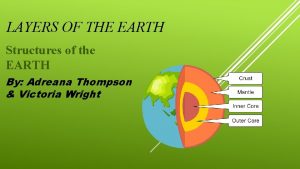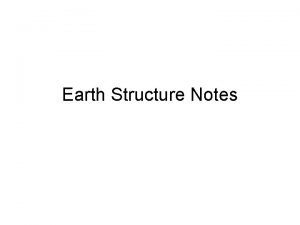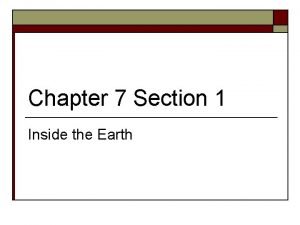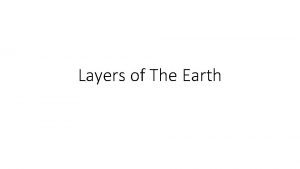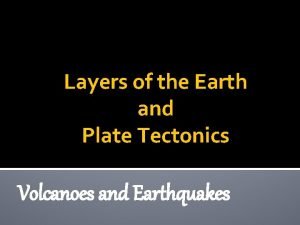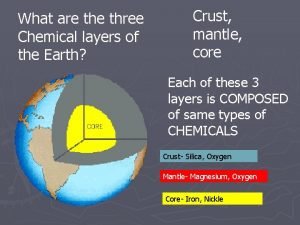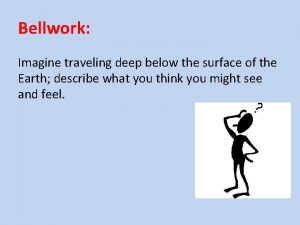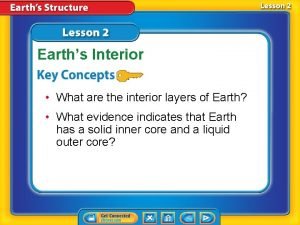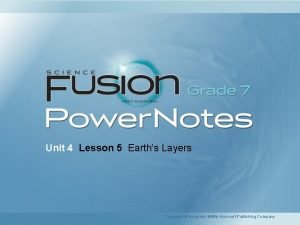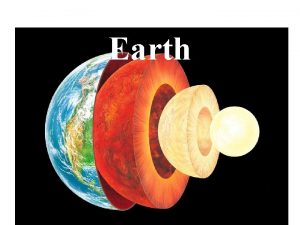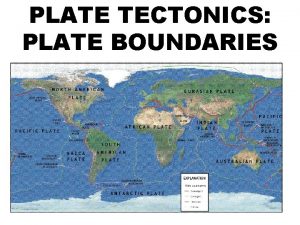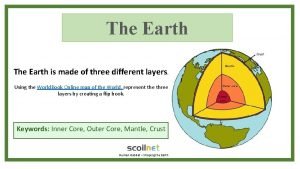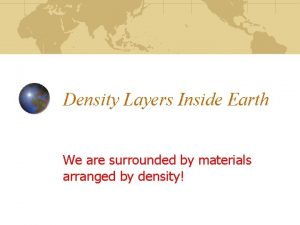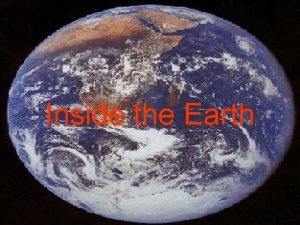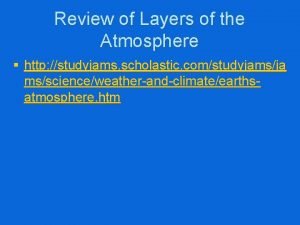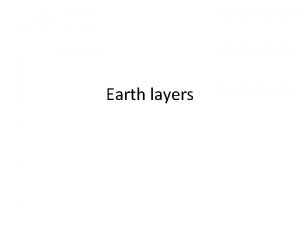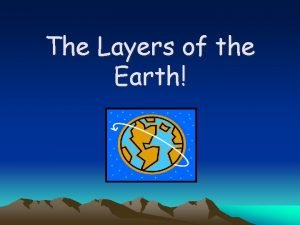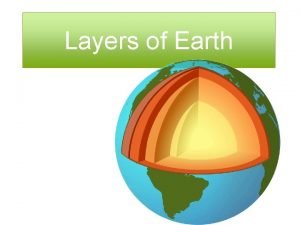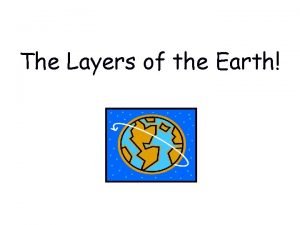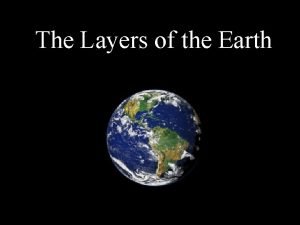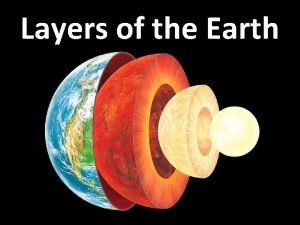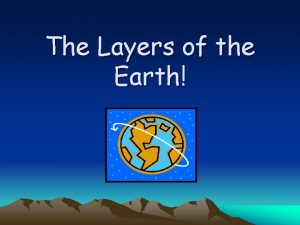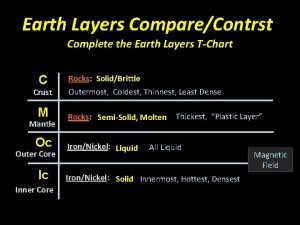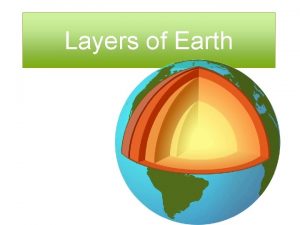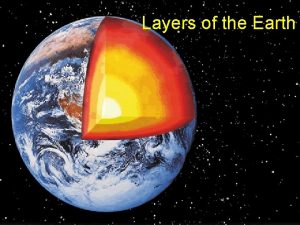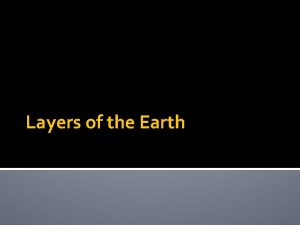Layers of the Earth Layers of the Earth




















- Slides: 20

Layers of the Earth

Layers of the Earth § There are two ways that scientists label the layers of the Earth. § Composition layers § Physical/Mechanical layers

Composition layers

Density § Earth’s layers are characterized by many things, one of which is density. § Density is the relationship between mass and volume § Density = mass/volume § The deeper you move towards the center of the earth, the denser (and hotter) the layer!

Composition layers § These are the more familiar layers. They are: § Crust § Ranges from 5 to 100 km in thickness § Thinnest layer of the Earth § Least dense § Split into two types: Continental and Oceanic § Continental is thicker than oceanic § Mantle § Roughly 2900 km thick – the thickest layer! § No one has ever drilled to the mantle. It is also very hot § Has properties of a liquid and a solid (it is plastic)

§ Core § Mostly made of iron and nickel § Outer core: liquid, very dense § Inner core: solid from pressure § temperatures and pressures so great the metals are squeezed together and are not able to move § The core’s diameter is roughly 6856 km (about the size of Mars)

Physical Layers

Physical Layers § The less familiar layers are the physical layers. They are based on how the layer looks or acts. § Lithosphere “rock sphere” (15 -300 km) § The tectonic plates § A combination of crust and the upper region of the mantle § Cold and brittle (easily broken) § Asthenosphere “weak sphere” (250 km) § Hard rock that acts like warm tar or honey (plastic) § Has properties of a liquid AND a solid § What the tectonic plates float on § HOT

Physical layers 2 § Mesosphere “middle sphere” (2550 km) § Rest of the mantle § Much stronger and hotter than the Asthenosphere § Outer Core (2200 km) § Liquid layer § Inner Core (diameter= 2456 km) § Solid, dense core of the planet

Interesting fact… § Did you know? . . . § The center of the Earth’s core is hotter than the surface of the sun. The temperature of Earth’s inner core reaches 6000 °C whereas the surface of the sun is roughly 5500 °C. § The sun’s core, however, is 15, 000 °C

Side by side comparison Crust Mantle Lithosphere Asthenosphere Mesosphere Core Outer Core Inner Core

Review 1) What are the four layers of the Earth? 2) The Earth’s crust is very ______? 3) The mantle is the largest layer of the Earth? True or False 4) Is the Outer Core a liquid or a solid?

Answers! 1) Crust, Mantle, Outer Core, Inner Core 2) Thin 3) True 4) Liquid

Plate Tectonics

Theory of Continental Drift § Theory by Alfred Wegener § Continental drift is theory that continents can drift apart from one another and have done so in the past. § Puzzling observations that could be explained by continental drift: § Puzzle-like fit of the continents § Fossils of the same plants and animals found on both sides of the Atlantic Ocean § Strange grooves cut by ancient glaciers that line up

Theory of Seafloor Spreading § Harry Hess was a geologist that studies the ocean floor § He discovered that the sea floor seemed to be pulling apart, and magma came up in the middle § This helps support Continental Drift!

Tectonic Plates § With the idea that continents can drift apart, scientists felt that some force had to be making these continents move. § The theory of plate tectonics developed as a way to explain continental drift

Tectonic Plates § Tectonic plates are large pieces of the lithosphere that move around on top of the asthenosphere like icebergs in the ocean. § There are 10 major plates

When plates collide! § Plate tectonics is theory that the Earth’s lithosphere is divided into large tectonic plates that move around on top of the asthenosphere. § All plates share boundaries with other plates, just like states share borders.

Boundaries § There are three main types of boundaries § Convergent § When plates push against each other § Divergent § When plates move away from each other § Transform § When plates slide against each other § Online animations
 The earth layer foldable
The earth layer foldable The core movie trailer
The core movie trailer Inner core composition
Inner core composition Layers of earth
Layers of earth Lithosphere ppt
Lithosphere ppt Three compositional layers of the earth
Three compositional layers of the earth Layers of earth
Layers of earth Two regions of the mantle
Two regions of the mantle Chemical and physical layers of the earth
Chemical and physical layers of the earth Which layer is the least dense
Which layer is the least dense How did deep mines and wells give clues to earth's interior
How did deep mines and wells give clues to earth's interior Types of crust
Types of crust Analogy of earth
Analogy of earth Geoscience processes
Geoscience processes What layers of earth make up the lithosphere
What layers of earth make up the lithosphere Layers of the earth flip book
Layers of the earth flip book The earth's layers foldable
The earth's layers foldable Geologic layers of earth
Geologic layers of earth Study jams atmosphere
Study jams atmosphere Properties of outer core
Properties of outer core Earth's layers
Earth's layers



